CBC
Wed, April 5, 2023
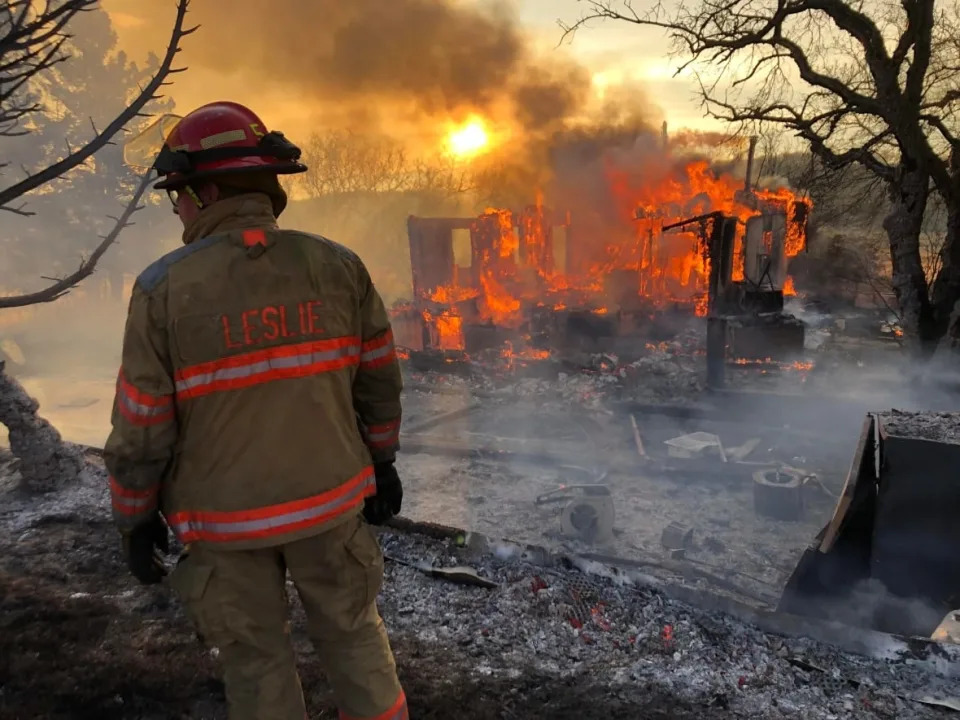
Last summer, the International Agency of Research on Cancer (IARC), the specialized cancer agency of the World Health Organization, declared firefighting as a Group 1 carcinogen. (Submitted by Ames Leslie - image credit)
Ames Leslie and his wife were grocery shopping in December when he felt a sharp pain on the left side of his torso. Concerned he was suffering from appendicitis, Leslie rushed to the emergency room.
Doctors and nurses tested him for hours, ruling out diagnoses one by one. Finally, an oncologist walked into the room: they believed he had testicular cancer.
"They say your mind goes blank and you kind of go to a different place — and it's 100 per cent true," Leslie said. "As soon as you hear that C-word, your mind just goes and you don't hear anything after that."
A urologist confirmed the diagnosis the following week. Four days later, he was in surgery getting tumours removed.
At 44, Leslie had been in good health otherwise. Two weeks before his diagnosis, he had passed a physical exam.
But as a firefighter in Battleford, Sask., Leslie had exposed himself to carcinogens almost every day for half of his life.
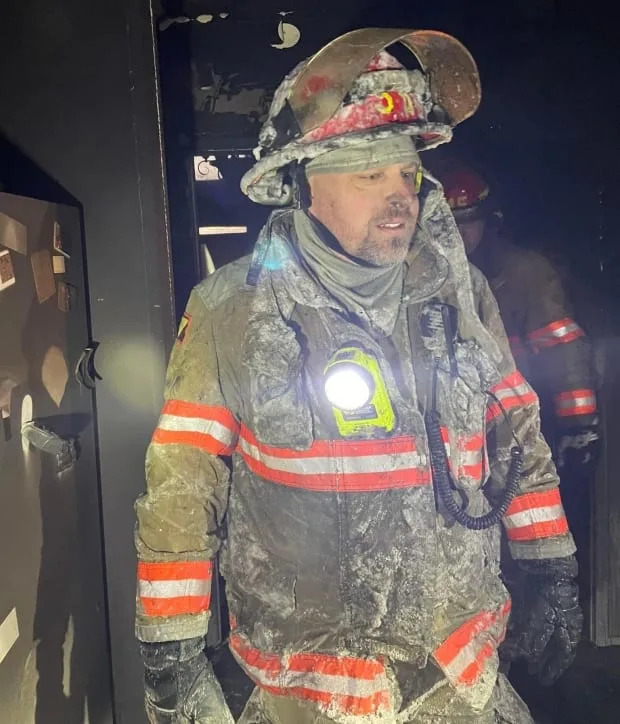
Submitted by Ames Leslie
Last summer, the International Agency of Research on Cancer (IARC), the specialized cancer agency of the World Health Organization, declared firefighting as a Group 1 carcinogen, meaning it found sufficient evidence to link the job to the risk of certain cancers. It's one of only five occupations to receive this designation.
The announcement was validating for firefighters, who were aware they were at higher risk of cancer but have had to lobby for decades to get presumptive workers' compensation coverage. For some, it still doesn't go far enough.
Firefighters told CBC News they have seen a change in how seriously their peers consider this risk. But as departments implement prevention measures and try to hammer messaging home, finite budgets and resources impede them from taking all of the necessary precautionary steps.
'Cancer on your gear'
Firefighters with ashen gear were once idolized.
"It was a badge of honour to have dirty, burnt, melted gear. It showed you've been to war and you survived — and you're ready to go again," said Tyler Packham, a veteran firefighter and president of the International Association of Fire Fighters (IAFF) Local 181, the Regina firefighters' union.
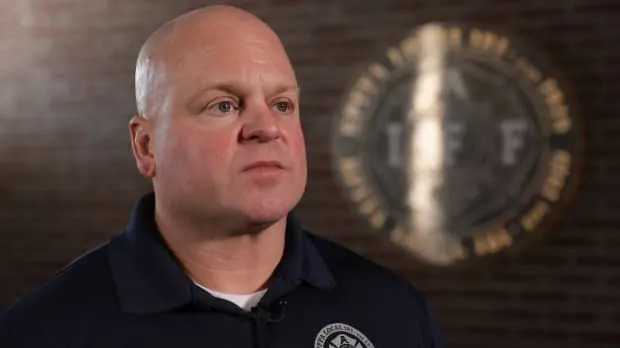
Kirk Fraser/CBC
"Now, we call it cancer on your gear."
The firefighters who spoke with CBC News described the job as a calling. Most chose the vocation as a way to give back to their community, regardless of the risks that come with jumping into a fire.
But the IARC designation and other emerging research on cancer risk have forced firefighters to reconcile that flames aren't the thing they need to be most concerned about.
Last year, 95 per cent of on-duty deaths among Canadian firefighters were linked to cancer. A 2018 study found cancer killed Canadian firefighters about three times more often than the general population.
Ringing the alarm
Saskatchewan hasn't been immune to this trend.
One in five workers who died from an occupational disease from 2011 to 2020 were firefighters diagnosed with cancer, according to the provincial Workers' Compensation Board (WCB) annual report. From 2010 to 2021, that amounted to 37 firefighters.
Top-5 causes of workplace fatalities in Sask., 2010-2021
In response, WorkSafe Saskatchewan, an organization forged by the WCB and Ministry of Labour Relations and Workplace Safety, brought in Jim Burneka.
Burneka, a firefighter in Dayton, Ohio, founded Firefighter Cancer Consultants in 2014. The organization tours fire departments and develops individualized plans to help with cancer prevention.
In 2019, he visited eight fire departments in Saskatchewan, from city stations to volunteer ones in small, rural communities.
"A lot of the firefighters weren't aware of truly how dangerous occupational firefighter cancer was to them," Burneka said.
Firefighters responding to a scene, particularly structural fires, can be exposed to various chemical and hazardous substances. They're also exposed to things like diesel exhaust from their own trucks.
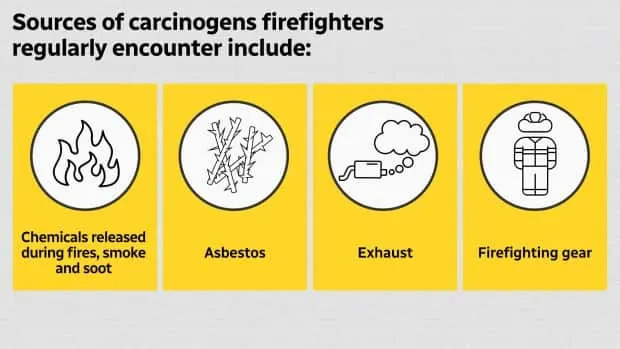
CBC News Graphics
"A big problem with structural firefighters is we don't know what they've been exposed to," said Nicola Cherry, an occupational epidemiologist and professor at the University of Alberta's medicine department.
Exposure, initially, was believed to occur from breathing in toxins, but further research has shown they can be absorbed through a person's skin, and ingested.
Cherry researched levels of carcinogens in the urine and blood of firefighters who responded to the Fort McMurray wildfire in 2016. She found higher levels in those who didn't have the opportunity to shower and change their clothes during the initial response.
Meanwhile, the gear designed to protect firefighters contains materials that are carcinogenic. Last August, the IAFF alerted its members about manufactured chemicals used in firefighter gear and, according to the United States' Agency for Toxic Substances and Disease Registry, some extinguisher foams.
As a result, firefighters wear their protective gear as little as possible. In Regina, they won't even let children pose for photos while donning it anymore, Packham said.
"It's a never-ending battle, and we're never going to get away from all the exposures," he said.
Reducing risk
As a result of the tour around Saskatchewan, Burneka teamed up with WorkSafe to create an educational and awareness campaign that outlines cancer prevention practices. Burneka also drafted an action plan, which lists more than 30 recommendations for fire services.
Most of the departments Burneka visited in 2019 had already started implementing such measures, but fell short in about 10 areas, including annual medical physicals and washing personal protective equipment (PPE) and soiled uniforms.
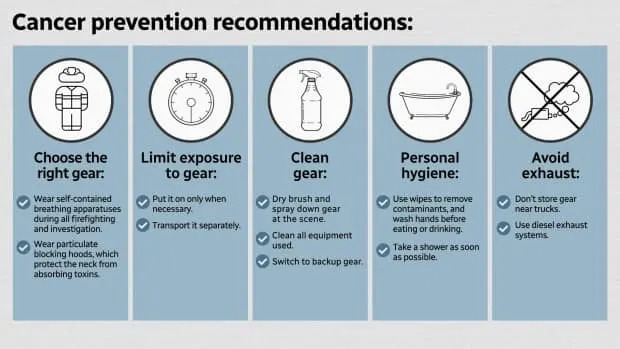
CBC News Graphics
A follow-up report by WorkSafe Saskatchewan in 2021 "indicated great improvement," but longer-term prevention measures, including backup sets of gear, "remain outstanding."
WorkSafe has highlighted the Weyburn Fire Department, in southern Saskatchewan, as a provincial leader in this area.
Once a fire is extinguished, firefighters will wash down their gear on scene.
When they return to the station, they are to go through a back bay, which acts as a decontamination area and follow a thorough step-by-step process.
WATCH | Weyburn Fire Chief Trent Lee gives tour of the station's cancer prevention measures:
Yet, Chief Trent Lee said the station has yet to implement crucial steps.
"Shower in an hour" is a mantra used across borders to remind firefighters to wash the soot that seeped under their gear off their bodies as soon as possible. But the Weyburn station doesn't have showers. Firefighters have to go home — possibly contaminating their family vehicles — to shower, Lee said.
He's advocating to build an addition to the station to house showers.
The station acquired a washer and dryer, but the latter currently isn't working, so firefighters are bringing their contaminated undergarments home, and mixing them with their family members' laundry.
Firefighters' gear should also be tailored to an individual's size, so soot doesn't sneak onto their bodies in the first place, Lee said. But most fire departments cannot afford that.
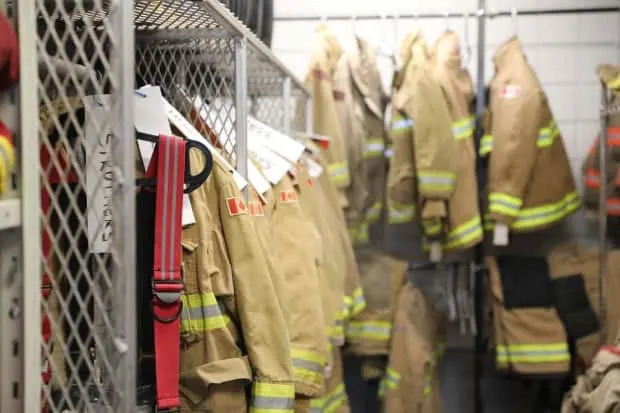
Nicholas Frew/CBC
Money constraints
The 2019 tour, Burneka said, highlighted the disparity between the resources available to Regina Fire and Protective Services, for example, and volunteer departments in rural areas.
"Budgets are very tight in the volunteer world," said Ken McMullen, president of the Canadian Association of Fire Chiefs and chief of Red Deer Emergency Services in Alberta.
About seven in 10 firefighters across Canada are volunteers, according to the association's latest firefighter census. Yet, volunteer departments often have to make tough decisions about how they spend money, McMullen said.
They may, for example, have to choose between purchasing a piece of equipment essential to firefighting, or an industrial washing machine that could better clean firefighter gear, or provide firefighters with a backup set of PPE, he said.
Lee, who once led a volunteer department, told CBC News that volunteer departments often accept hand-me-downs from larger departments. Sometimes, firefighters show up to a scene in street clothes, or without a proper respirator.
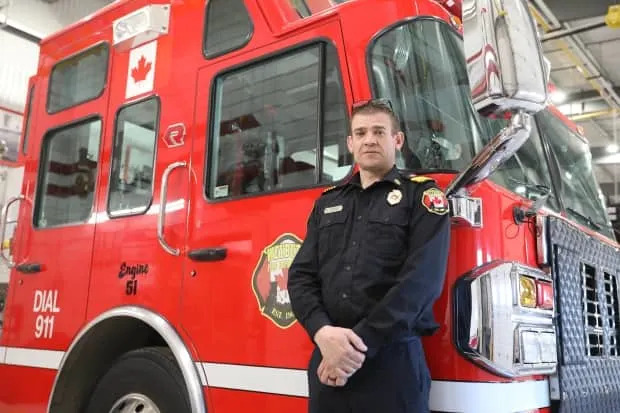
Nicholas Frew/CBC
"It's just so expensive," Lee said.
"We do all of these things on pennies, and it's tremendous what these smaller volunteer departments can do with little-to-no budget."
Saskatchewan Government Insurance spent $5.6 million on training and equipment for volunteer firefighter departments last year, according to a provincial government spokesperson.
Even if they were to receive more money or grants, firefighters recognize their risk of cancer can never be eliminated from the line of duty, which is why they're calling for more help for if — and when — they get sick.
Even coverage
Sherry Romanado was a firefighter kid. Her father was a volunteer firefighter in Greenfield Park, now a borough of Longueuil, Que. From a young age, she was playing in the station, learning to roll hose and occasionally sporting her father's gear.
Romanado eventually became the Liberal MP for the Longueuil—Charles-LeMoyne constituency. In 2018, a firefighter told her his cancer diagnosis wasn't covered through workers' compensation. Lobbyists brought up the issue again a couple of years later on Parliament Hill.
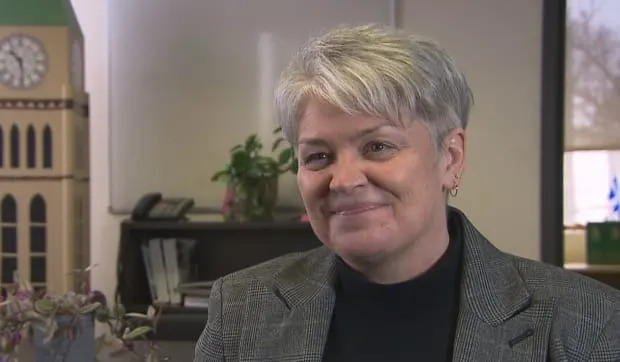
Simon Martel/CBC
"There was an inequity and it really bothered me," said Romanado, whose husband is a volunteer firefighter. "How could someone who's doing the same job in one province be covered, but not in another province?"
Workers' compensation legislation across Canada has adapted over the years to provide presumptive coverage fir certain types of cancer for full-time and volunteer firefighters. But which cancers are covered and what conditions must be met to be eligible for benefits — such as how long you had to have worked in the job — vary by province.
Quebec, for example, is the only province where firefighters can receive compensation for mesothelioma, an aggressive and deadly cancer the IARC has linked to the profession. But overall, Quebec covers the fewest cancers in Canada.
The Saskatchewan Workers' Compensation Board covers 16 cancers — but not the one that has Packham concerned.
Presumptive firefighter cancer coverage by province, territory
Last summer he attended a conference, where a company was offering free cancer scans. His found an abnormality.
A biopsy later found a mass on his thyroid. He is currently waiting for another biopsy to see if the mass has grown.
"If it actually is thyroid cancer, I'm currently not covered. But if I lived three hours down the road in Brandon, Man., I would be covered," Packham said.
The Saskatchewan government continues to work with the Saskatchewan Professional Firefighters and Paramedics Association and "others," regarding further presumptive cancer coverage, a provincial government spokesperson said.
Discrepancies in coverage for firefighters on First Nations is an ongoing issue, too.
Shane Bair's father died three months after he was diagnosed with colon cancer. He was 62. Randy Bair had served about 35 years as a volunteer firefighter, most of which was spent working in Muskoday First Nation, about 130 kilometres northeast of Saskatoon.
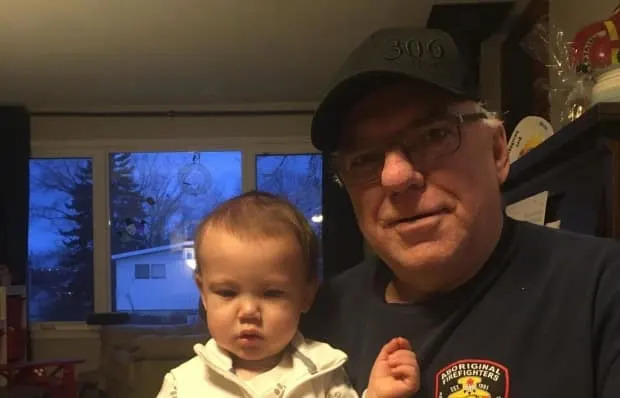
Submitted by Shane Bair
Soon after his father's death in 2021, Shane learned Randy wasn't covered under provincial workers' compensation benefits.
"We're actively trying to change that," said Shane, the fire Chief of Beaver Lake Cree Nation in Alberta. "WCB is working with us to draft a policy to make sure that doesn't happen again."
The legislation in Saskatchewan covers volunteer firefighters, but Shane said it does not recognize First Nations as a municipality, excluding their employees from workers compensation coverage.
The Saskatchewan WCB is in chats with Saskatchewan First Nations Emergency Management, an organization that works to provide all First Nations in the province with emergency services, about presumptive cancer coverage, a provincial government spokesperson said.
Uniformity, in part, is why Romanado introduced Bill C-224, the National Framework on Cancers Linked to Firefighting Act. The bill recently passed the House of Commons unanimously and is awaiting its second reading in the Senate.
The bill aims to raise awareness of cancers linked to firefighting and improve access to prevention and treatment for firefighters. If it receives royal assent, it would promote sharing information across jurisdictions and improve data collection about prevention and treatment, among other things.
"This is about saving lives," Romanado said.
Gaps in the system
Firefighters told CBC News there's a need for health care to catch up. Some have experienced long wait times for tests and appointments, and have had to travel to see specialists. Some have had doctors who did not recognize, or dismissed, the increased risk of cancer among firefighters.
"The process here in Saskatchewan is depressing," Lee said. "It causes a lot of anxiety and mental turmoil."
Many firefighters want CT scans to be included as part of their annual physical exams.
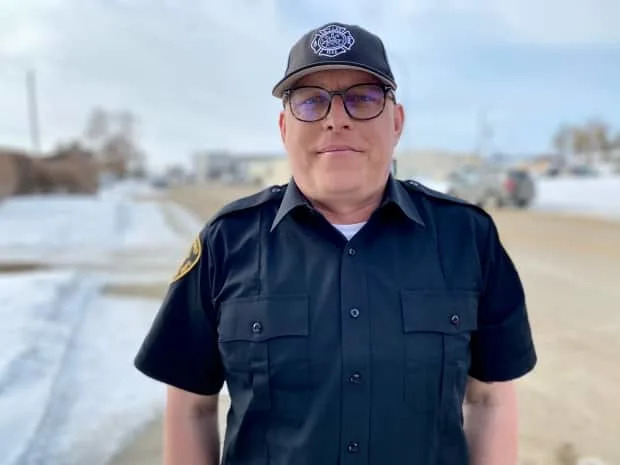
Travis Reddaway/CBC
Leslie is among those calling for early screening, because he's convinced early detection saved his life.
Having recently completed his third round of chemotherapy, he has gone through the stages of grief. When he spoke with CBC News in mid-March, he hadn't suffered from any major physical side effects, such as nausea, but he was still adjusting to being bald and clean-shaven.
He has not started the process to confirm whether his job contributed to his diagnosis but, unable to work, he has spent his days researching cancer and its risk to firefighters.
He has also looked for government grants to protect the trees along nearby walking trails, tackled many crosswords, read books, napped and listened to music. He's now particularly fond of orchestral music — a new bond shared with his son, a music performance student at Western University in Ontario.
Leslie has nine more rounds of chemotherapy to go. His doctors hope to conduct more scans in mid-May, which, he hopes, will give him a clean bill of health.
No comments:
Post a Comment